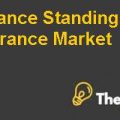
Deutsche Bank Securities: Financing the Acquisition of Consolidated Supply S.A.
Case Questions
Question 1
What is the problem in the case?
The Vice President of the Deutsche Bank Securities, Maria Ober had received a loan request for financing of one of the bid related to a large hospital supply distributor on November 20, 2003. The offer price for the proposed acquisition and the financial commitment indications were both due in about 2 weeks time.
This transaction was based upon a very significant level of the debt; therefore, it was a highly leveraged acquisition for Deutsche Bank Securities.
The problem facing Deutsche Bank Securities is now to analyze the deal, place a valuation on the firm, identify the valuation of the future possible synergies and then make a final decision. Deutsche Bank Securities has also contributed in such financings in the past also and the reason for this was the profitability of the transaction which was quite huge.
Moreover, the core problem underlining this case is not make a yes or a no decision for this proposed financing request but it focuses more on changing the design structure of the transaction in order to make it more fruitful for some of the related parties to this transaction. Apart from this a detailed credit analysis also needs to be performed for the target company in order to determine the significance of risk inherent in this proposed deal for Deutsche Bank Securities and all other related parties.
Question 2
What is the CSSA worth?
The actual worth of CSSA could be determined through a number of approaches. Initially beginning with identifying the true worth of CSSA the internal rate of return for this transaction as provide in case exhibit 10 of 21.3% could be compared to an appropriate benchmark and if it exceeds that benchmark then CSSA could be considered as worthy for investment. The internal rate of return of 21.3% reflects the return which would be earned by the target equity holders therefore; the most appropriate benchmark to compare this equity holder’s return would be the target company’s cost of equity.
In order to identify the cost of equity, the capital asset pricing model has been used in order to estimate the target firm’s cost of equity. The excel spreadsheet shows the calculations for the cost of equity. The beta has been unlevered and then re-levered to reflect the leverage of the target firm and the same level of risk. The cost of equity thus ranges from 9.4% to 12.6% and the internal rate of return is 21.3%, therefore, based upon this approach CSSA seems to be worthy and the valuation for CSSA also looks attractive.
However, there are a lot of studies which show that default risk is not captured by the levered beta and as a result of this the return which is required by the equity holders is understated and it might result in wrong decisions being taken. The private equity investors usually demand a rate of return in the range of 25%-35%. The case also states a target required rate of return for the private equity investors of 30%. If the return generated by this deal of 21.3# is compared with the required rate of return of 30%, then the valuation of CSSA and its worth seems quite weak.
Apart from these approaches, the valuation of the firm could be performed on the basis of the projected cash flows and growth assumptions. Through this approach the worth of the firm could be evaluated in more depth based on economic view. The bid which has been placed upon CSSA is $ 1.513 billion. A detailed discounted cash flow model has been created for the firm based upon the projected free cash flow calculations.
The discount rate calculations have also been performed based upon the new weights and the costs associated with debt and equity for CSSA. The terminal growth rate has been stated to be 4-5% therefore, 4% has been used in this case in order to compute the terminal value beyond 2013. The total valuation for CSSA has been found to be $ 3.148 billion based upon the discounted cash flow method. This valuation is $ 1.635 billion in excess of the purchase price as provided in exhibit 6.
Apart from this the valuations have also been computed for CSSA based on other multiples approaches which could be seen in the excel spreadsheet. Each of the valuation approach shows that excess value would be generated as compared to the purchase price of $ 1.513 billion.
The graph could also be seen for the range of the valuations based upon different approaches for CSSA. All of these valuations suggest that ICL is paying an adequate purchase price and it is not overpaying in this deal. This deal is going to generate a plenty of value for the firm along with the total of $ 979 million of funded debt..........
This is just a sample partial case solution. Please place the order on the website to order your own originally done case solution










